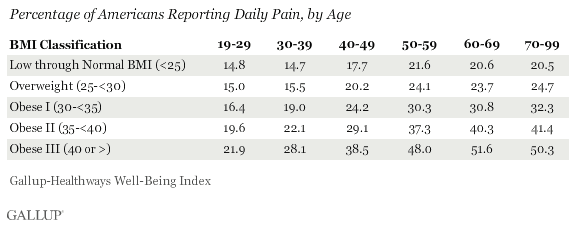STONY BROOK, NY -- U.S. adults who are obese report higher rates of daily pain than those who are not, according to Gallup-Healthways Well-Being Index surveys of more than 1 million Americans. In fact, the higher an individual's Body Mass Index (BMI) score, the more likely he or she is to report experiencing pain, with 44.1% of those with BMIs of 40 or higher saying so.

Gallup and Healthways calculate BMI scores based on respondents' self-reports of their height and weight collected as part of the Gallup-Healthways Well-Being Index. Respondents answered questions about pain between 2008 and 2010, including if they experienced pain yesterday and if they had pain conditions in the last year.
Sixty-three percent of the 1,010,762 people who responded to the survey were classified as overweight (38%) or obese (25%). Obese respondents were further classified into one of three obesity levels as defined by the World Health Organization.
BMI-Pain Link Stronger for Women and Older Americans
The link between obesity and pain is even stronger for women and older Americans. Obese women have higher rates of pain than obese men do, and the gender difference widens as BMI increases.

Additionally, as Americans age, excess weight is associated with even more pain -- especially for people aged 40 and older. This finding suggests a developmental process in which individuals who have chronic pain conditions, such as arthritis or other rheumatic diseases, may reduce their physical activity levels, which in turn leads to elevated BMIs. Alternately, older, normal-weight Americans were only slightly more likely than younger Americans to report daily pain.

Implications
This study, originally published in the online edition of Obesity, confirms and extends earlier studies about the link between obesity and pain. However, this analysis uses a larger sample size and controls for variables including age, gender, race, education, presence of health insurance, and smoking behavior.
The study found that "pain yesterday" was more common among individuals with diseases that cause bodily pain. However, even after controlling for these diseases, the relationship between obesity and pain still exists. This finding suggests that obesity alone may cause pain, even without the presence of painful diseases.
There could be several explanations for the relationship between obesity and pain. These include the possibility that having excess fat in the body triggers complex physiological processes that result in inflammation and pain; depression, often experienced by obese individuals, is also linked to pain; and medical conditions that cause pain, such as arthritis, might result in lower levels of exercise, thereby resulting in weight gain.
The study demonstrates the need for further investigation of the obesity and pain link in U.S. populations.
Arthur A. Stone, Ph.D., is a Gallup Senior Scientist and a leading researcher in the advancement of behavioral medicine at Stony Brook University.
Survey Methods
Results are based on telephone interviews conducted as part of the Gallup Healthways Well-Being Index survey Jan. 2, 2008-June 30, 2010, with a random sample of more than 1 million adults, aged 18 and older, living in all 50 U.S. states and the District of Columbia.
Interviews are conducted with respondents on landline telephones and cellular phones, with interviews conducted in Spanish for respondents who are primarily Spanish-speaking. Each sample includes a minimum quota of 400 cell phone respondents and 600 landline respondents per 1,000 national adults, with additional minimum quotas among landline respondents for gender within region. Landline telephone numbers are chosen at random among listed telephone numbers. Cell phones numbers are selected using random digit dial methods. Landline respondents are chosen at random within each household on the basis of which member had the most recent birthday.
Samples are weighted by gender, age, race, Hispanic ethnicity, education, region, adults in the household, and phone status (cell phone-only/landline only/both, cell phone mostly, and having an unlisted landline number). Demographic weighting targets are based on the March 2010 Current Population Survey figures for the aged 18 and older non-institutionalized population living in U.S. telephone households. All reported margins of sampling error include the computed design effects for weighting and sample design.
In addition to sampling error, question wording and practical difficulties in conducting surveys can introduce error or bias into the findings of public opinion polls.
For more details on Gallup's polling methodology, visit https://www.gallup.com/.
